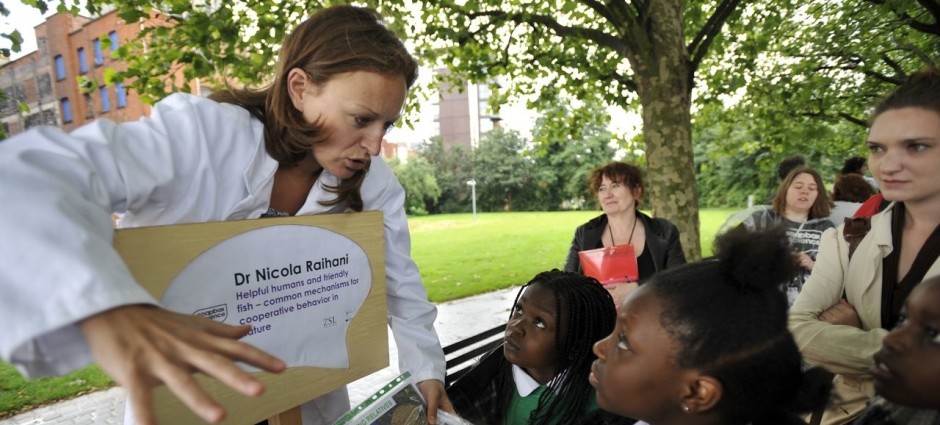 Andrea Strakova is a PhD student at the University of Cambridge. Andrea will be standing on one of our soapboxes in Bristol on 15th July. Come and hear her talk entitled: “Crazy canine cancer: A look at how thousands years old dog cancer travelled the world”
Andrea Strakova is a PhD student at the University of Cambridge. Andrea will be standing on one of our soapboxes in Bristol on 15th July. Come and hear her talk entitled: “Crazy canine cancer: A look at how thousands years old dog cancer travelled the world”
Photo credit: Elizabeth Murchison
Studying the world’s oldest cancer
by Andrea Strakova
I have, for a long time, been excited to understand the biology of the world’s oldest cancer – a cancer which is around 10,000 years old! How is it even possible for a cancer to exist for such a long time…?! This was my very first thought when I found out about canine transmissible venereal tumour (or CTVT for short) – an infectious cancer which affects man’s best friend, the dog.
 My interest was sparked during my undergraduate studies in Veterinary Science at the University of Cambridge, when I learnt about this unusual and biologically extraordinary canine cancer. I was immediately fascinated by this disease – I decided to focus on studying CTVT during my final year undergraduate project, which naturally led on to a PhD, allowing me to dig deeper and follow my excitement and interests!
My interest was sparked during my undergraduate studies in Veterinary Science at the University of Cambridge, when I learnt about this unusual and biologically extraordinary canine cancer. I was immediately fascinated by this disease – I decided to focus on studying CTVT during my final year undergraduate project, which naturally led on to a PhD, allowing me to dig deeper and follow my excitement and interests!
Photo credit: Anna Czupryna
So WHAT is so special about CTVT, the canine cancer which I am still so passionately studying (and hope to continue in the future as well)? Let me now take you on a journey back in time…and I hope that by the end of this story, you will be interested to learn even more about this unique canine cancer, too!
Let’s now move back in time to the age when mammoths were still roaming the world, to a time around 10,000 years ago. You can now imagine a dog, which lived all this time ago…and this particular dog got a cancer. We know that cancer is a disease of our own DNA – the genetic information which is stored in our cells. When the cell acquires changes in its DNA – called mutations, it may start dividing more and more; it divides uncontrollably and this may lead to the formation of a tumour. This is what happened in our particular dog living 10,000 years ago…but there was more to come.
 Normally, the cancer would die when the individual that gave rise to it dies. But in that one particular dog living 10,000 years ago, something very, very unusual happened. The cancer, instead of dying with this dog, managed to survive beyond the death of that particular dog…through transmission of living cancer cells on to another individual. And from then, the cancer has spread through the dog population all over the world as an infectious disease, and it is still surviving until this date. So now, here we are in the 21st century, and we can still see the cells of that original dog living 10,000 years ago – hugely transformed…”hopping” between dogs and living on them, almost like parasites!
Normally, the cancer would die when the individual that gave rise to it dies. But in that one particular dog living 10,000 years ago, something very, very unusual happened. The cancer, instead of dying with this dog, managed to survive beyond the death of that particular dog…through transmission of living cancer cells on to another individual. And from then, the cancer has spread through the dog population all over the world as an infectious disease, and it is still surviving until this date. So now, here we are in the 21st century, and we can still see the cells of that original dog living 10,000 years ago – hugely transformed…”hopping” between dogs and living on them, almost like parasites!
Photo credit: Alan Allum
And how do these cells “jump” between dogs? Remember, that in our story, the cells from the original dog are still alive today. So instead of the cancer being caused by an infectious agent (such as a virus, as is the case in cervical cancer and Human Papilloma Viruses (HPVs)), here we can “see” the actual living cancer cells moving between individual dogs (usually by direct contact during mating). This is something quite unexpected – normally, our immune system should detect the cancer cells as “foreign” or “different” and they should be destroyed. But not in this infectious dog cancer.
So what is my goal? I would like to continue working on this ancient and mysterious canine disease – I hope to learn more about the biology of CTVT, and understand how is it that this cancer has survived for such a long time by hopping from a dog to dog, and hiding from the effects of the immune system.
In my PhD work, I have been very fortunate to have the support of incredible mentors (especially my fantastic supervisor Dr Elizabeth Murchison) and veterinary collaborators from many parts of the world and I am very grateful for all the opportunities and knowledge I have gained along the way. Now I hope that I can share my excitement with the public, too – through being a small part of the fantastic work being done through the Soapbox Science events!
Are you interested to learn more about CTVT and my research work?
http://www.tcg.vet.cam.ac.uk/directory/andrea-strakova
